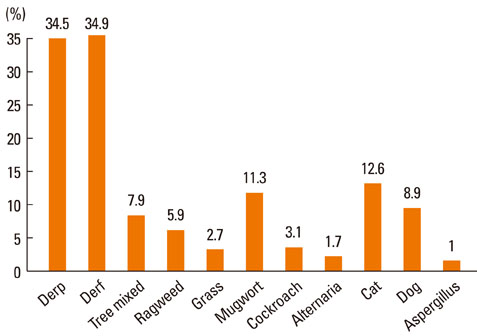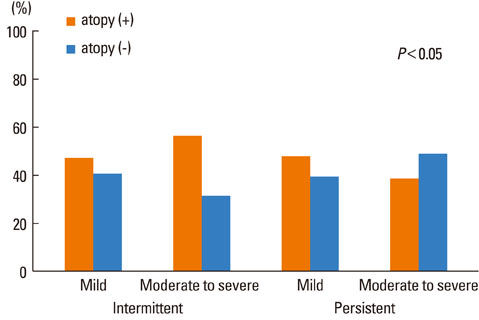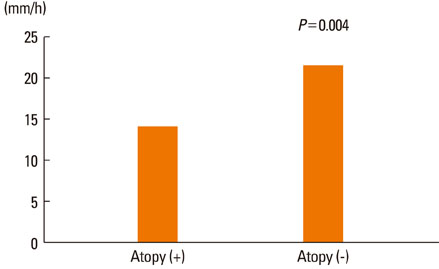Allergy Asthma Immunol Res.
2013 May;5(3):143-149. 10.4168/aair.2013.5.3.143.
Impact of Atopy on Asthma and Allergic Rhinitis in the Cohort for Reality and Evolution of Adult Asthma in Korea
- Affiliations
-
- 1Department of Internal Medicine, Soonchunhyang University College of Medicine, Seoul, Korea. schalr@schmc.ac.kr
- 2Department of Internal Medicine, Hanyang University College of Medicine, Seoul, Korea.
- 3Department of Internal Medicine, University of Ulsan College of Medicine, Seoul, Korea.
- 4Department of Internal Medicine, Seoul National University College of Medicine, Seoul, Korea.
- 5Department of Internal Medicine, Yonsei University College of Medicine, Seoul, Korea.
- 6Department of Internal Medicine, Ajou University College of Medicine, Suwon, Korea.
- 7Department of Internal Medicine, Ewha Womans University College of Medicine, Seoul, Korea.
- 8Department of Internal Medicine, Chung-Ang University College of Medicine, Seoul, Korea.
- KMID: 2260333
- DOI: http://doi.org/10.4168/aair.2013.5.3.143
Abstract
- PURPOSE
Atopy is an important cause of asthma. Few data on the prevalence of atopy or comparisons with clinical characteristics of asthma in Korean patients have been published. We evaluated the effects of atopy on clinical profiles and airway inflammation in Korean asthmatics.
METHODS
We retrospectively enrolled 1,492 asthmatics from the Cohort for Reality and Evolution of Adult Asthma in Korea (COREA) cohort who had undergone skin prick tests for aeroallergens. The patients' clinical characteristics, lung function, PC20, and sputum and blood inflammatory cell counts were compared based on the presence or absence of atopy. Atopy was defined as one or more positive reactions (A/H ratio >1) on a skin prick test.
RESULTS
Among 11 aeroallergens, house dust mites (Dermatophagoides farinae and Dermatophagoides pteronyssinus) were the most prevalent cause of a positive skin prick test. As compared with non-atopic asthmatics, atopic asthmatics showed early onset of the disease. Atopic patients with asthma had a higher FEV1, FVC, and FEV1/FVC as compared with non-atopic patients with asthma. In addition, asthmatics without atopy had more uncontrolled asthma (P=0.001) and severe rhinitis (P<0.05) as compared with atopic asthmatics. Smoking, as measured in pack years, was higher in the non-atopic asthmatics than in the atopic asthmatics. The erythrocyte sedimentation rate was higher in non-atopic asthmatics than in the atopic asthmatics and patients with non-atopic asthma had a higher sputum neutrophil count than did those with atopic asthma.
CONCLUSIONS
Our data indicate that atopic asthmatics had an early onset of disease and high IgE levels, while the non-atopic asthmatics had decreased lung function and a high sputum neutrophil count, suggesting that a different approach is needed to treat atopic asthma.
Keyword
MeSH Terms
Figure
Cited by 2 articles
-
Factors related to Asthma in Korean Adults: A Secondary Data Analysis of the Korea National Health and Nutrition Examination Survey from 2016
Mi-Jeong Yun
Korean J Adult Nurs. 2019;31(3):259-268. doi: 10.7475/kjan.2019.31.3.259.Association Between Clinical Burden and Blood Eosinophil Counts in Asthma: Findings From a Korean Adult Asthma Cohort
Mi-Yeong Kim, Eun-Jung Jo, Sujeong Kim, Min-Hye Kim, Jae-Woo Jung, Joo-Hee Kim, Ji-Yong Moon, Jae-Woo Kwon, Jae-Hyun Lee, Chan Sun Park, Hyun Jung Jin, Yoo Seob Shin, Sae-Hoon Kim, Young-Joo Cho, Jung-Won Park, Sang-Heon Cho, Tae-Bum Kim, Hye-Kyung Park
J Korean Med Sci. 2022;37(7):e57. doi: 10.3346/jkms.2022.37.e57.
Reference
-
1. Mokdad AH, Serdula MK, Dietz WH, Bowman BA, Marks JS, Koplan JP. The spread of the obesity epidemic in the United States, 1991-1998. JAMA. 1999; 282:1519–1522.2. Mannino DM, Homa DM, Akinbami LJ, Moorman JE, Gwynn C, Redd SC. Surveillance for asthma--United States, 1980-1999. MMWR Surveill Summ. 2002; 51:1–13.3. Fanta CH. Asthma. N Engl J Med. 2009; 360:1002–1014.4. Jansson SA, Rönmark E, Forsberg B, Löfgren C, Lindberg A, Lundbäck B. The economic consequences of asthma among adults in Sweden. Respir Med. 2007; 101:2263–2270.5. Seaton A, Godden DJ, Brown K. Increase in asthma: a more toxic environment or a more susceptible population? Thorax. 1994; 49:171–174.6. Shin TS, Lee GJ, Yoon HS. A survey of the distribution of allergic diseases in primary school children. Allergy. 1990; 10:201–212.7. Cookson W. The alliance of genes and environment in asthma and allergy. Nature. 1999; 402:B5–B11.8. Prescott SL, Macaubas C, Holt BJ, Smallacombe TB, Loh R, Sly PD, Holt PG. Transplacental priming of the human immune system to environmental allergens: universal skewing of initial T cell responses toward the Th2 cytokine profile. J Immunol. 1998; 160:4730–4737.9. Stein RT, Sherrill D, Morgan WJ, Holberg CJ, Halonen M, Taussig LM, Wright AL, Martinez FD. Respiratory syncytial virus in early life and risk of wheeze and allergy by age 13 years. Lancet. 1999; 354:541–545.10. Halonen M, Stern DA, Lohman C, Wright AL, Brown MA, Martinez FD. Two subphenotypes of childhood asthma that differ in maternal and paternal influences on asthma risk. Am J Respir Crit Care Med. 1999; 160:564–570.11. Venables KM, Chan-Yeung M. Occupational asthma. Lancet. 1997; 349:1465–1469.12. Platts-Mills TA. The role of immunoglobulin E in allergy and asthma. Am J Respir Crit Care Med. 2001; 164:S1–S5.13. Gould HJ, Sutton BJ, Beavil AJ, Beavil RL, McCloskey N, Coker HA, Fear D, Smurthwaite L. The biology of IGE and the basis of allergic disease. Annu Rev Immunol. 2003; 21:579–628.14. Burrows B, Martinez FD, Halonen M, Barbee RA, Cline MG. Association of asthma with serum IgE levels and skin-test reactivity to allergens. N Engl J Med. 1989; 320:271–277.15. Menz G, Ying S, Durham SR, Corrigan CJ, Robinson DS, Hamid Q, Pfister R, Humbert M, Kay AB. Molecular concepts of IgE-initiated inflammation in atopic and nonatopic asthma. Allergy. 1998; 53:15–21.16. Platts-Mills TA, Erwin EA, Heymann PW, Woodfolk JA. Pro: The evidence for a causal role of dust mites in asthma. Am J Respir Crit Care Med. 2009; 180:109–113.17. Tovey ER, Almqvist C, Li Q, Crisafulli D, Marks GB. Nonlinear relationship of mite allergen exposure to mite sensitization and asthma in a birth cohort. J Allergy Clin Immunol. 2008; 122:114–118.18. Granada M, Wilk JB, Tuzova M, Strachan DP, Weidinger S, Albrecht E, Gieger C, Heinrich J, Himes BE, Hunninghake GM, Celedón JC, Weiss ST, Cruikshank WW, Farrer LA, Center DM, O'Connor GT. A genome-wide association study of plasma total IgE concentrations in the Framingham Heart Study. J Allergy Clin Immunol. 2012; 129:840–845.e21.19. Kim TB, Park CS, Bae YJ, Cho YS, Moon HB. COREA Study Group. Factors associated with severity and exacerbation of asthma: a baseline analysis of the cohort for reality and evolution of adult asthma in Korea (COREA). Ann Allergy Asthma Immunol. 2009; 103:311–317.20. National Asthma Education and Prevention Program. Expert Panel Report: Guidelines for the Diagnosis and Management of Asthma Update on Selected Topics--2002. J Allergy Clin Immunol. 2002; 110:S141–S219.21. Bousquet J, Khaltaev N, Cruz AA, Denburg J, Fokkens WJ, Togias A, Zuberbier T, Baena-Cagnani CE, Canonica GW, van Weel C, Agache I, Aït-Khaled N, Bachert C, Blaiss MS, Bonini S, Boulet LP, Bousquet PJ, Camargos P, Carlsen KH, Chen Y, Custovic A, Dahl R, Demoly P, Douagui H, Durham SR, van Wijk RG, Kalayci O, Kaliner MA, Kim YY, Kowalski ML, Kuna P, Le LT, Lemiere C, Li J, Lockey RF, Mavale-Manuel S, Meltzer EO, Mohammad Y, Mullol J, Naclerio R, O'Hehir RE, Ohta K, Ouedraogo S, Palkonen S, Papadopoulos N, Passalacqua G, Pawankar R, Popov TA, Rabe KF, Rosado-Pinto J, Scadding GK, Simons FE, Toskala E, Valovirta E, van Cauwenberge P, Wang DY, Wickman M, Yawn BP, Yorgancioglu A, Yusuf OM, Zar H, Annesi-Maesano I, Bateman ED, Ben Kheder A, Boakye DA, Bouchard J, Burney P, Busse WW, Chan-Yeung M, Chavannes NH, Chuchalin A, Dolen WK, Emuzyte R, Grouse L, Humbert M, Jackson C, Johnston SL, Keith PK, Kemp JP, Klossek JM, Larenas-Linnemann D, Lipworth B, Malo JL, Marshall GD, Naspitz C, Nekam K, Niggemann B, Nizankowska-Mogilnicka E, Okamoto Y, Orru MP, Potter P, Price D, Stoloff SW, Vandenplas O, Viegi G, Williams D. World Health Organization. GA(2)LEN. AllerGen. Allergic Rhinitis and its Impact on Asthma (ARIA) 2008 update (in collaboration with the World Health Organization, GA(2)LEN and AllerGen). Allergy. 2008; 63:Suppl 86. 8–160.22. Wickman M. Experience with quantitative IgE antibody analysis in relation to allergic disease within the BAMSE birth cohort--towards an improved diagnostic process. Allergy. 2004; 59:Suppl 78. 30–31.23. Wickman M, Lilja G, Söderström L, van Hage-Hamsten M, Ahlstedt S. Quantitative analysis of IgE antibodies to food and inhalant allergens in 4-year-old children reflects their likelihood of allergic disease. Allergy. 2005; 60:650–657.24. Park CS, Kim YY, Kang SY. Collection between RAST and skin test for inhalant offending allergens. Allergy. 1983; 3:1–9.25. Park SW, Lee YM, Jang AS, Lee JH, Hwangbo Y, Kim DJ, Park CS. Development of chronic airway obstruction in patients with eosinophilic bronchitis: a prospective follow-up study. Chest. 2004; 125:1998–2004.26. Lötvall J, Akdis CA, Bacharier LB, Bjermer L, Casale TB, Custovic A, Lemanske RF Jr, Wardlaw AJ, Wenzel SE, Greenberger PA. Asthma endotypes: a new approach to classification of disease entities within the asthma syndrome. J Allergy Clin Immunol. 2011; 127:355–360.27. Holt PG, Sly PD. Interaction between adaptive and innate immune pathways in the pathogenesis of atopic asthma: operation of a lung/bone marrow axis. Chest. 2011; 139:1165–1171.28. Jang AS, Lee JH, Park SW, Shin MY, Kim DJ, Park CS. Severe airway hyperresponsiveness in school-aged boys with a high body mass index. Korean J Intern Med. 2006; 21:10–14.29. Jang AS, Son MH, Choi IS, Koh YI. High body mass index is associated with wheezing among older adults living in high-altitude area in Korea. J Korean Med Sci. 2002; 17:479–482.30. Magnussen H, Watz H. Systemic inflammation in chronic obstructive pulmonary disease and asthma: relation with comorbidities. Proc Am Thorac Soc. 2009; 6:648–651.31. Girdhar A, Kumar V, Singh A, Menon B, Vijayan VK. Systemic inflammation and its response to treatment in patients with asthma. Respir Care. 2011; 56:800–805.32. Olafsdottir IS, Gislason T, Thjodleifsson B, Olafsson I, Gislason D, Jögi R, Janson C. C reactive protein levels are increased in non-allergic but not allergic asthma: a multicentre epidemiological study. Thorax. 2005; 60:451–454.33. Sutherland TJ, Cowan JO, Young S, Goulding A, Grant AM, Williamson A, Brassett K, Herbison GP, Taylor DR. The association between obesity and asthma: interactions between systemic and airway inflammation. Am J Respir Crit Care Med. 2008; 178:469–475.34. Thomson NC, Spears M. The influence of smoking on the treatment response in patients with asthma. Curr Opin Allergy Clin Immunol. 2005; 5:57–63.35. Centers for Disease Control and Prevention (CDC). State-specific prevalence of current cigarette smoking among adults--United States, 2002. MMWR Morb Mortal Wkly Rep. 2004; 52:1277–1280.36. Rickards L, Fox K, Roberts C, Fletcher L, Goddard E. Living in Britain: results from the 2002 General Household Survey [Internet]. London: Office for National Statistics;2004. accessed 2004 Aug 20. Available from: http://onstest.landmarkgovernment.co.uk/ons/rel/ghs/general-household-survey/2002-edition/living-in-britain--full-report.pdf.37. Althuis MD, Sexton M, Prybylski D. Cigarette smoking and asthma symptom severity among adult asthmatics. J Asthma. 1999; 36:257–264.38. Siroux V, Pin I, Oryszczyn MP, Le Moual N, Kauffmann F. Relationships of active smoking to asthma and asthma severity in the EGEA study. Epidemiological study on the Genetics and Environment of Asthma. Eur Respir J. 2000; 15:470–477.39. Silverman RA, Boudreaux ED, Woodruff PG, Clark S, Camargo CA Jr. Cigarette smoking among asthmatic adults presenting to 64 emergency departments. Chest. 2003; 123:1472–1479.40. Apostol GG, Jacobs DR Jr, Tsai AW, Crow RS, Williams OD, Townsend MC, Beckett WS. Early life factors contribute to the decrease in lung function between ages 18 and 40: the Coronary Artery Risk Development in Young Adults study. Am J Respir Crit Care Med. 2002; 166:166–172.41. Lange P, Parner J, Vestbo J, Schnohr P, Jensen G. A 15-year follow-up study of ventilatory function in adults with asthma. N Engl J Med. 1998; 339:1194–1200.42. Marquette CH, Saulnier F, Leroy O, Wallaert B, Chopin C, Demarcq JM, Durocher A, Tonnel AB. Long-term prognosis of near-fatal asthma. A 6-year follow-up study of 145 asthmatic patients who underwent mechanical ventilation for a near-fatal attack of asthma. Am Rev Respir Dis. 1992; 146:76–81.43. Gallefoss F, Bakke PS. Does smoking affect the outcome of patient education and self-management in asthmatics? Patient Educ Couns. 2003; 49:91–97.44. Sippel JM, Pedula KL, Vollmer WM, Buist AS, Osborne ML. Associations of smoking with hospital-based care and quality of life in patients with obstructive airway disease. Chest. 1999; 115:691–696.45. Wardlaw AJ, Dunnette S, Gleich GJ, Collins JV, Kay AB. Eosinophils and mast cells in bronchoalveolar lavage in subjects with mild asthma. Relationship to bronchial hyperreactivity. Am Rev Respir Dis. 1988; 137:62–69.46. Djukanović R, Wilson JW, Britten KM, Wilson SJ, Walls AF, Roche WR, Howarth PH, Holgate ST. Quantitation of mast cells and eosinophils in the bronchial mucosa of symptomatic atopic asthmatics and healthy control subjects using immunohistochemistry. Am Rev Respir Dis. 1990; 142:863–871.47. Humbert M, Durham SR, Ying S, Kimmitt P, Barkans J, Assoufi B, Pfister R, Menz G, Robinson DS, Kay AB, Corrigan CJ. IL-4 and IL-5 mRNA and protein in bronchial biopsies from patients with atopic and nonatopic asthma: evidence against "intrinsic" asthma being a distinct immunopathologic entity. Am J Respir Crit Care Med. 1996; 154:1497–1504.48. Wenzel SE, Szefler SJ, Leung DY, Sloan SI, Rex MD, Martin RJ. Bronchoscopic evaluation of severe asthma. Persistent inflammation associated with high dose glucocorticoids. Am J Respir Crit Care Med. 1997; 156:737–743.49. Jatakanon A, Uasuf C, Maziak W, Lim S, Chung KF, Barnes PJ. Neutrophilic inflammation in severe persistent asthma. Am J Respir Crit Care Med. 1999; 160:1532–1539.50. Wenzel SE, Schwartz LB, Langmack EL, Halliday JL, Trudeau JB, Gibbs RL, Chu HW. Evidence that severe asthma can be divided pathologically into two inflammatory subtypes with distinct physiologic and clinical characteristics. Am J Respir Crit Care Med. 1999; 160:1001–1008.
- Full Text Links
- Actions
-
Cited
- CITED
-
- Close
- Share
- Similar articles
-
- Relationship Between Atopy and Bronchial Hyperresponsiveness
- Allergic Rhinitis and Its Impact on Asthma Update (ARIA 2008) Korean Perspective
- Skin Prick Testing of Patients with Allergic Rhinitis and/or Asthma: a Study in Catholic Medical Center, Korea
- Evaluation and Control of Allergic Rhinitis in Adult Patients with Asthma (CARINA) in Korea
- Allergic rhinitis, sinusitis and asthma: evidence for respiratory system integration





